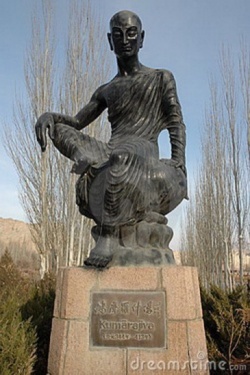Chinese Buddhism on the Silk Road
The Chinese Empire extended its frontiers into Central Asia during the first century BCE. From this time, and perhaps even earlier, China had contact with Buddhism through the movement of traders and missionaries along the Silk Road. The Han emperor Mingdi (who reigned from 57/58 to 75/76 CE) is said by tradition to have been a devotee of both Buddhism and Daoism, and to have sent emissaries to India in search of Buddhist texts.
Buddhist missionaries were at work in China, translating Buddhist Shravakayana texts into Chinese, from the middle of the first century CE onwards. Towards the end of this century, the first translations of Mahayana texts into Chinese were made under the translator Lokashema. These still remain the oldest known editions of Mahayana literature.
The Schools of Chinese Buddhism
From the fifth century, when a major effort was made to translate the major sutras and commentaries of the Mahayana into Chinese under the translator Kumarajiva, some of the Indian Buddhist Mahayana traditions, such as Madhyamaka, were represented in China, and major new schools developed in the following century. These were the Tiantai, who based their teachings on the Lotus sutra, the Huayan, who based their teachings on the Avatamsaka sutra, and the Jingtu, who followed the practices set out in the Pure Land sutras. In the following century a new school which emphasized meditation appeared, called Chan, the Chinese version of the Sanskrit word dhyana. The school is now best known by its Japanese name Zen. There was also a Vajrayana school, Zhenyen ('mantra') which was established in the eighth century but died out in the ninth.
Chinese Buddhism in Central Asia
During the Sui dynasty (581-618) Buddhism flourished as the state religion, and continued to flourish in the Tang dynasty (618-907) until a great persecution was carried out by the emperor in 845. This period of Buddhism's greatest success in China was also the period when China's control over Central Asia was at its strongest. During this period, Chinese Buddhist literature and art appeared in Central Asia, along the nothern Silk Road, as far westward as the oasis state of Kucha.The best examples of Chinese Buddhist paintings and manuscripts are from the monastic cave complex at Dunhuang. In one of the caves of this complex a great cache of Chinese manuscripts was discovered. Most of these are Buddhist texts, generally dating from the period of the Tang dynasty, although the earliest dated scroll is from the fifth century CE and the latest from the late tenth century. The character of Chinese Buddhism of the period is reflected in these Dunhuang manuscripts. The sutras are mostly Mahayana. There are many treatises on meditation by the Chan school, which flourished in China during the Tang dynasty, as well as numerous scriptures and prayers of the Pure Land tradition.The eventual decline of the importance of Dunhuang as a Buddhist centre was probably due to a combination of causes. As Chinese power in Central Asia waned, Dunhuang became more peripheral. Furthermore, the decline of the influence of Buddhism in China itself and the gradual conversion of other Central Asia peoples to Islam from the ninth century onwards meant that there would have been less and less support for a major Buddhist centre.
